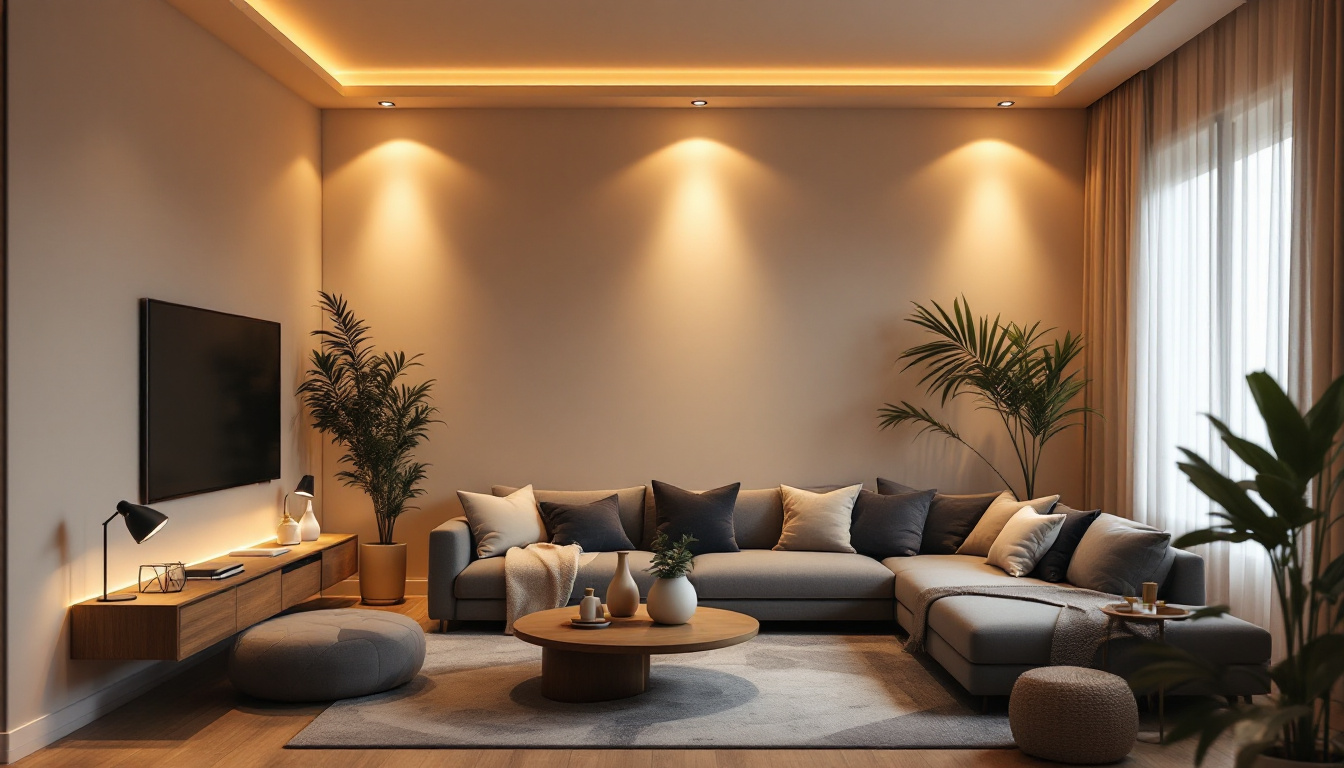
Lighting is an essential aspect of any construction or renovation project, and recessed pot lights have become increasingly popular among homeowners and commercial property owners alike. For lighting contractors, understanding the nuances of recessed lighting installation and design can significantly enhance the quality of their work and customer satisfaction. This article delves into the top strategies that lighting contractors can employ when working with recessed pot lights.
Recessed pot lights, also known as can lights or downlights, are fixtures that are installed into the ceiling, providing a sleek and unobtrusive lighting solution. They are designed to illuminate a space without taking up visual real estate, making them ideal for various applications, from residential living rooms to commercial offices.
These fixtures come in various sizes, shapes, and styles, allowing contractors to choose the right option for different environments. Understanding the technical specifications, such as wattage, lumens, and color temperature, is crucial for achieving the desired lighting effect. For instance, a higher lumen output is essential for spaces requiring bright illumination, such as kitchens or workspaces, while softer, warmer tones may be more suitable for bedrooms or relaxation areas.
There are several types of recessed pot lights available, each serving distinct purposes. Some of the most common types include:
Recessed pot lights offer numerous advantages that make them a preferred choice for many contractors. Firstly, they provide a clean and modern aesthetic, enhancing the overall appearance of a space. Secondly, they are versatile and can be used for ambient, task, or accent lighting, depending on the design requirements.
Moreover, recessed lights can improve the functionality of a room by ensuring even illumination, reducing shadows, and creating a more inviting atmosphere. Their energy efficiency, especially with the advent of LED technology, also makes them a cost-effective choice for homeowners. In addition to these benefits, recessed pot lights can be integrated with smart home systems, allowing for remote control and customization of lighting settings. This feature not only enhances convenience but also enables homeowners to create dynamic lighting scenes that can adapt to different activities or moods throughout the day.
Furthermore, the installation of recessed pot lights can significantly increase the resale value of a property. Potential buyers often appreciate the modern look and the energy-saving benefits associated with these fixtures. With the right placement and design, recessed lighting can highlight architectural features, artwork, or landscaping, making spaces feel more luxurious and thoughtfully designed. As a result, investing in recessed pot lights can be a strategic decision for both aesthetic enhancement and long-term property value appreciation.
Effective planning is critical when it comes to the layout of recessed pot lights. A well-thought-out design can significantly impact the overall lighting quality and ambiance of a space. Contractors should consider various factors, including the size of the room, the height of the ceiling, and the intended use of the space.
One of the primary considerations in planning the layout is determining the appropriate spacing between recessed lights. A common rule of thumb is to space the fixtures approximately 4 to 6 feet apart, but this can vary based on the light output and the specific application. For example, in areas requiring more concentrated lighting, such as kitchens or workspaces, closer spacing may be necessary.
Additionally, the distance from the wall should also be taken into account. Placing lights too close to the wall can create harsh shadows, while positioning them too far can lead to insufficient illumination. A balanced approach ensures that the light is distributed evenly throughout the room.
The height of the ceiling plays a crucial role in the effectiveness of recessed lighting. In rooms with high ceilings, deeper recessed fixtures may be required to ensure adequate light distribution. Conversely, in lower ceilings, shallow fixtures can provide a more streamlined look without overwhelming the space.
Contractors should also consider the beam angle of the fixtures. A narrower beam angle is suitable for higher ceilings, as it allows the light to reach the floor effectively. In contrast, wider beam angles work well in lower ceilings, providing broader coverage.
With a plethora of options available in the market, selecting the right recessed pot lights can be daunting. However, understanding the various features and specifications can simplify the decision-making process.
Energy efficiency is a significant consideration for both contractors and clients. LED recessed pot lights are increasingly becoming the standard due to their low energy consumption and long lifespan. They produce less heat compared to traditional incandescent bulbs, making them a safer choice for enclosed spaces.
When selecting LED fixtures, contractors should pay attention to the color temperature, which can significantly affect the mood of a space. Warmer tones (2700K-3000K) create a cozy atmosphere, while cooler tones (4000K-5000K) are more suitable for task-oriented areas.
The trim of a recessed pot light can alter its appearance and functionality. Various styles are available, including baffle, reflector, and adjustable trims. Baffle trims are designed to reduce glare, making them ideal for living spaces, while reflector trims can enhance brightness in areas requiring more light.
Contractors should also consider the aesthetic preferences of their clients. Sleek, modern trims can complement contemporary designs, while more decorative options may suit traditional or rustic interiors. Offering a range of styles can help meet diverse client needs.
Proper installation is crucial for the performance and longevity of recessed pot lights. Lighting contractors must adhere to best practices to ensure a successful installation process.
Before installation, it’s essential to assess the electrical requirements of the recessed lights. Contractors should ensure that the circuit can handle the total wattage of all installed fixtures. Additionally, using the correct gauge wire is vital to prevent overheating and potential fire hazards.
When wiring recessed lights, it’s advisable to follow local electrical codes and regulations. This includes ensuring proper grounding and using suitable connectors for secure and safe connections.
Accurate measurements are critical when cutting holes for recessed lights. Using a template can help ensure that the holes are cut to the correct size and shape, reducing the risk of mistakes. Contractors should also be cautious of any existing plumbing or wiring in the ceiling to avoid damage during installation.
Once the holes are cut, it’s essential to double-check the positioning before securing the fixtures in place. A level and straight installation not only enhances the aesthetic appeal but also ensures optimal light distribution.
After installation, testing the recessed pot lights is a crucial step that should not be overlooked. Ensuring that each fixture operates correctly and provides the desired light output is essential for client satisfaction.
Many recessed lights come with dimming capabilities, allowing for adjustments in light levels based on the time of day or specific activities. Contractors should demonstrate how to use dimmers effectively, enabling clients to create the desired ambiance in their spaces.
In addition to dimming, it may be necessary to adjust the angle of adjustable fixtures to ensure they highlight specific areas or features. This attention to detail can significantly enhance the overall lighting design.
Educating clients about the operation and maintenance of their recessed pot lights is an essential part of the installation process. Providing information on bulb replacement, cleaning, and troubleshooting can empower clients to take care of their lighting systems effectively.
Offering guidance on how to maximize the benefits of their new lighting can also lead to increased client satisfaction and potential referrals for future projects.
The lighting industry is continuously evolving, with new technologies and design trends emerging regularly. For lighting contractors, staying informed about these changes is vital for maintaining a competitive edge.
Smart lighting technology has gained significant traction in recent years. Integrating recessed pot lights with smart home systems allows clients to control their lighting remotely, set schedules, and even adjust brightness and color temperature through mobile applications.
Contractors should familiarize themselves with the various smart lighting options available and how they can be integrated into recessed lighting systems. This knowledge can enhance the value of their services and appeal to tech-savvy clients.
As sustainability becomes a priority for many homeowners and businesses, lighting contractors should consider eco-friendly practices in their projects. This includes recommending energy-efficient fixtures, utilizing recyclable materials, and minimizing waste during installation.
By adopting sustainable practices, contractors can not only contribute to environmental conservation but also attract clients who prioritize eco-friendly solutions.
Recessed pot lights offer a versatile and aesthetically pleasing lighting solution for various spaces. By implementing the strategies outlined in this article, lighting contractors can enhance their skills and provide exceptional service to their clients. From understanding the types of fixtures available to mastering installation techniques and staying updated with industry trends, these strategies can lead to successful projects and satisfied customers.
Ultimately, the key to success in the lighting industry lies in a commitment to quality, continuous learning, and a passion for creating beautiful, functional spaces through effective lighting design.
Ready to elevate your lighting projects with the finest recessed pot lights on the market? Look no further than LumenWholesale, where we provide contractors with exceptional, spec-grade lighting products at unbeatable wholesale prices. Say goodbye to local distributor markups and hello to a vast selection of top-tier lighting that meets rigorous industry standards. Plus, with free shipping on bulk orders, you can stock up on premium lighting solutions without worrying about hidden fees. Don’t compromise on quality or cost. Visit LumenWholesale today and discover the ultimate in quality, affordability, and convenience for all your lighting needs.

Discover the essential role of three-way switches for lighting contractors, learn key installation tips, and boost your projects’ efficiency—upgrade your expertise today!.

Discover why T5 light fixtures are becoming a top choice for lighting contractors.

Explore the essential role of dimmer lights in modern lighting installations.

Discover why ceiling fan light kits are essential tools for lighting contractors.